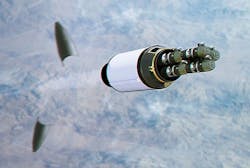Lockheed Martin moves forward with design of sophisticated missile defense sensor seeker
Officials of the U.S. Missile Defense Agency (MDA) in Huntsville, Ala., announced a $53.1 million contract last week to the Lockheed Space Systems segment in Sunnyvale, Calif., for the Multi-Object Kill Vehicle MOKV technology risk reduction (TRR) effort.
As many as six MOKVs will launch on one booster rocket, deploy at the edge of space, steer toward, and destroy several incoming ballistic missile warheads and decoys using separate kinetic hit-to-kill weapons.
This contract calls for Lockheed Martin experts to refine their design for the MOKV gimbaled seeker assembly, integrated avionics assembly, and advanced seeker, as well as carry out component integration and testing.
Related: Boeing joins Lockheed Martin and Raytheon to develop multi-warhead killer missile defense
The MDA's design approach for the MOKV consists of concept definition, risk reduction, and proof of concept before MDA officials decide on pursuing a full development program. This contract represents part of the Missile Defense Agency’s technology risk reduction strategy.
The Raytheon Co. Missile Systems segment in Tucson, Ariz., and the Boeing Defense, Space & Security segment in Huntsville, Ala. also have been involved in MOKV development. Lockheed Martin, Raytheon, and Boeing all won MOKV concept definition contracts in August 2015.
When put to use, military forces will load several MOKVs on one missile-defense rocket, such as the three-stage Ground-Based Interceptor (GBI). After launch, each MOKV will steer toward an incoming ballistic missile warhead or decoy to destroy it.
Each interceptor rocket will have an advanced sensor and divert, attitude-control, and communications technologies, to enable each MOKV to home-in on its target. Each MOKV will have its own sensor and diverting thrusters.
Related: Raytheon to build RIM-174 SM-6 shipboard air-defense missiles in $270.5 million contract
If MDA officials and other senior military leaders decide to proceed with MOKV development, production of these sophisticated missile-defense warheads could begin in 2022.
The MOKV program is an alternative to the now-cancelled Multiple Kill Vehicle (MKV) program, which sought to develop a hovering system with several kill vehicles. Like the MOKV, the MKV project aimed at destroying several incoming missile warheads and decoys with one missile launch. The MKV project was cancelled in 2009.
On this contract Lockheed Martin will do the work in Sunnyvale and Goleta, Calif., and in Bethesda, Md., and should be finished by March 2020.
For more information contact Lockheed Martin Space Systems online at www.lockheedmartin.com/us/ssc.html, or the Missile Defense Agency at www.mda.mil.
Learn more: search the Aerospace & Defense Buyer's Guide for companies, new products, press releases, and videos
